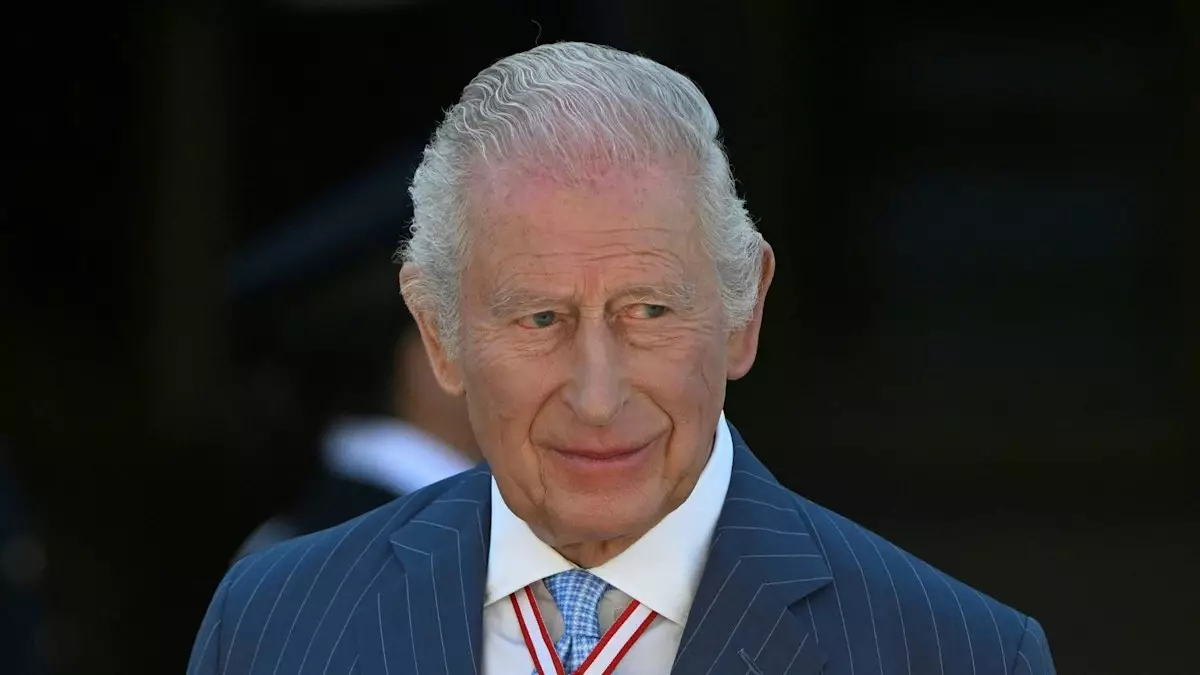In a vibrant show of engagement with the public, King Charles III was spotted beaming and waving to his admirers during his visit to St Mary Magdalene Church in Sandringham. Dressed impeccably in a dark grey suit complemented by a crisp white shirt and a stylish tie, the 76-year-old monarch radiated warmth and approachability—a stark reminder of the modern royalty’s endeavor to connect with their subjects on a personal level. This familiar sight of a kind ruler reaching out to his people symbolizes not merely a ceremonial duty but an essential component of his reign, reflecting an understanding that sincere interaction breeds admiration and loyalty from the populace.
However, the event had an unexpected twist: Queen Camilla, usually by the King’s side during such appearances, was noticeably absent. Her absence raises speculations about her wellbeing in light of their recent grueling schedule abroad. The royal couple recently returned from a two-day visit to Canada, where they engaged in numerous back-to-back events, culminating in a significant speech during Canada’s parliamentary opening. Coupled with an upcoming summer marked by high-profile events like Trooping the Colour and a state visit from President Macron, it raises the question: is the monarchy pacing itself to sustain its public duties while navigating personal challenges?
The Canadian Reception: A Heartwarming Homecoming
Charles and Camilla’s engagement in Canada displayed a newfound vigor in their representation of the monarchy beyond British shores. The King’s heartfelt 26-minute address received enthusiastic applause, and the warmth of the Canadian people’s response seems to affirm his place as a beloved figure in the Commonwealth. Royal engagements like these are not simply ceremonial; they signify a rekindling of connections that often become strained over time. Whether it was behaviors like greeting crowds at Lansdowne Park or honoring those at the war memorial, their royal presence captured the essence of monarchy’s fundamental role—to unite and inspire.
Recognition from locals had an emotional impact on the King. In remarks shared via a senior royal aide, he expressed that the visit represented a meaningful reconnection with a realm he governs from afar. The acknowledgement of shared history and culture transcended geographic boundaries, echoing sentiments that resonated deeply with many Canadians. This trip indicated not just a political gesture, but a sincere effort to reinvigorate relationships and foster a sense of belonging in the Commonwealth.
Personal Trials and Public Duty: The King’s Indomitable Spirit
Further complicating this period for King Charles III is the personal health challenge he openly navigates—cancer. Despite ongoing treatment, the King remains publicly vibrant and committed to fulfilling his royal duties. As indicated by royal aides, he refrains from allowing his health issues to dictate the frequency or nature of his public presence, embodying the very spirit of perseverance. Such tenacity provides an inspiring narrative of strength, one that deeply resonates with individuals who face their own battles.
The King’s approach contrasts with traditional views of leadership and wellness, particularly in royal circles often characterized by a certain aloofness. Instead of retreating behind palace walls, Charles aims to “manage” his cancer, demonstrating a practical and heartfelt acceptance of his condition. This perspective not only emphasizes the importance of normalcy amidst adversity but also aligns with contemporary views about health and well-being—focusing on living fully rather than succumbing to limitations.
Looking Ahead: A Monarchy in Transition
As the monarchy stands on the brink of numerous upcoming events, it has become increasingly clear that King Charles III’s reign may symbolize a transformative period for the British royal family. The blend of fulfilling royal obligations while managing personal health creates an environment ripe for evolution within the royal narrative. The foundation laid by Charles and Camilla regarding accessibility, connection, and resilience holds the potential to redefine public perceptions of the monarchy.
This transformation will not be without its challenges, yet the King’s recent public engagements exhibit a sincere commitment toward rejuvenating ties with their diverse populace. In this era of adaptability and vulnerability, the monarchy has a rare opportunity to mirror the common struggles faced by many, evolving into a royal family that remains both regal and relatable. By embracing these attributes, King Charles III is not only reshaping his own narrative but writing a new chapter for the British monarchy, one that is heavily underscored by authenticity and heart.

